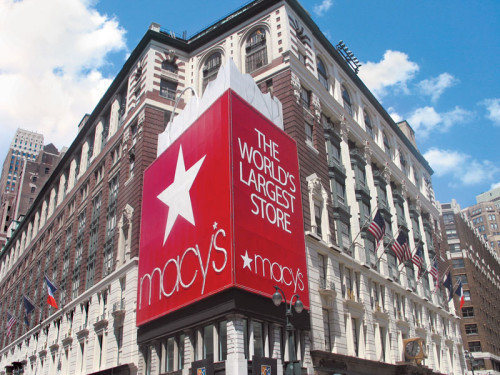25 Years of Retail Growth — And Consolidation

The last 25 years have been tumultuous for big apparel retailers, with major consolidation among department stores and the upward trajectory of discount and off-price on the one hand and luxury on the other — with a bit less in the middle.
The history of major American department store retailers in the last 25 years is very much the history of what is now Macy’s. It’s a long, meandering tale and we all know how it ends: with dozens of regional nameplates being merged into one giant—and for the most part dominant—830-store omni-channel chain.
Along the way we’ve seen Walmart and Target using very different strategies to fight for the discount market. Two other very different approaches to retailing have recently combined in the merger of Men’s Wearhouse and Jos. A. Bank. JCPenney seems to be slowly righting itself after a bold but ill-fated experiment in everyday low pricing. Nordstrom has maintained a reputation for excellent service while diversifying through acquisitions of Haute Look and Trunk Club, two business models that would barely be imaginable 25 years ago. Speaking of new business models, Amazon.com, which launched in 1995, did $75 billion in sales in 2013, up 22 percent from 2012. And finally, an American real estate mogul named Richard Baker created a Canadian-based retail empire when he realized that the Lord & Taylor chain he acquired for its land value was worth keeping for its retail potential, and then acquired Hudson’s Bay and Saks Fifth Avenue.
The End of an Era: Ed Finkelstein and the old Macy’s
Former Macy’s boss Ed Finkelstein, who died last June at the age of 89, brought it into the modern age with concepts like the brightly lit basement housewares department, re-introducing the Macy’s 4th of July Fireworks show and launching private brands that are still important today, like Alfani, INC and Charter Club. But Finkelstein’s glory days in the ’70s and ’80s waned when his push to acquire Federated failed. Instead, Macy’s bought two of Federated’s chains—I. Magnin and Bullock’s—in 1988 for $1.1 billion. In 1992, it was over. Macy’s filed for bankruptcy protection and Finkelstein was forced to retire. “The day of the merchant prince in retailing is rapidly drawing to a close,” Northwestern University marketing professor Louis W. Stern told The New York Times.
The Peak of Dayton Hudson and the Birth of Target Corp.
The Minneapolis-based department store chain Dayton Hudson led our March 1993 ranking of the top 50 retailers of menswear, with $2.55 billion in men’s and boys’ wear sales. In the early ’90s, Dayton Hudson was a powerful force in retailing: it included the Target discount chain (founded in 1962), Mervyn’s (acquired in 1978) and Marshall Field’s (acquired in 1990). The company’s new trajectory was hinted at in 2000 when it changed its name to Target Corp. A year later, in a move that Macy’s would eventually duplicate, the company changed all of its Dayton’s and Hudson’s store nameplates to Marshall Field’s—the chain in its portfolio with the highest national profile. In 2004, Target Corp. sold its 62 Marshall Field’s stores in May Department Stores and its Mervyn’s stores to an investment group.
The Dawn of the Walmart Era
In 1989, Walmart’s profits rose nearly 30 percent to reach $1 billion for the first time. Sales for that year shot up 25 percent to more than $25 billion; it was now the largest retailer in the country by sales volume. In 1990, the Arkansas-based retailer began a big expansion that brought it nationwide, opening its first stores in California on the West Coast and Pennsylvania in the Northeast. By 1995 it had conquered the U.S. and expanded into Mexico and Canada.
While independent retailers have feared national chains since the late-19th century and the arrival of the Sears and Montgomery Ward catalogs, Walmart was different. It grew by being the biggest store in small towns and gained a reputation for overwhelming local retailers. “Apparel store sales dropped fairly steadily in the Wal-Mart towns in the years following the opening of a Wal-Mart store, ending at 28 percent below the pre-Wal-Mart level after 10 years,” Iowa State University economics professor Kenneth Stone wrote in a widely cited 1997 study of the retailer’s impact on rural Iowa.
The Federated and May Merger
In 2005, Federated’s 450 Macy’s, Bloomingdale’s and co-branded Bon-Macy’s, Burdines-Macy’s, Goldsmith’s-Macy’s, Lazarus-Macy’s and Rich’s-Macy’s stores merged with May’s 491 stores under the Famous-Barr, Filene’s, Foley’s, Hecht’s, Kaufmann’s, Lord & Taylor, L.S. Ayres, Marshall Field’s, Meier & Frank, Robinsons-May, Strawbridge’s and The Jones Store nameplates. The deal also included May’s David’s Bridal, 449 After Hours Formalwear and a few other businesses. The two companies were pretty evenly matched in terms of revenue—Federated had annual sales of $15.6 billion to May’s $14.4 billion—although May operated in more of the country and had about 20,000 more employees.
“Today, we have taken the first step toward combining two of the best department store companies in America, creating a new retail company with truly national scope and presence,“ said Federated CEO Terry Lundgren at the time. The new company was now in 49 states, and the switch from almost two dozen local store names to all Macy’s was swift.
The Next 25 Years
The future is uncertain. We know that in 2019, three major luxury retailers (two new to the New York market) will open new Manhattan flagships: Saks Fifth Avenue downtown, Nordstrom in Midtown and Neiman Marcus on the West Side Hudson Yards development. Several retailers, like Macy’s and Bloomingdale’s, are looking beyond North America to places like Dubai and Abu Dabi. Many have been in China for years: Walmart has nearly 300 stores and Gap just celebrated its 100th. We know that major brick-and-mortar retailers are continuing to pursue an increasingly seamless blend of in-store and online sales. We know that the off-price market is evolving to a point where certain retailers known for luxury have off-price divisions that are outpacing their regular-price businesses.
But the outlook is hazy with a flurry of questions: will Amazon open brick-and-mortar stores? Can any American retailer thrive in Canada? (Or even survive—now that Target is pulling out.) Will three-day shipping become free across the board, with same-day shipping as the new frontier? Is Uniqlo poised to become the next Gap in America? Will Gap and Banana Republic ever recover their former glory? Is the flash sale concept already finished? Will JCPenney only find success through a refusal to evolve? Will Sears and Kmart go the way of Montgomery Ward? How many more stores will the big chains have to close before the market reaches a balance? You’ve got questions; MR will keep seeking answers.
Mega Merchants
MR’s ranking of the top 10 retailers of men’s and boys’ wear by sales volume in North America
March 1993
Dayton Hudson
JCPenney
Walmart
Sears
Kmart
Melville
May Dept. Stores
Gap
Federated
R.H. Macy & Co.
June 1999
Walmart
JCPenney
Dayton Hudson
Gap
Sears
Federated
T.J. Maxx
May Dept. Stores
Kmart
Dillard’s
June 2005
Walmart
Gap
Federated
JCPenney
Target Corp.
TJX Companies
Kohl’s
May Dept. Stores
Sears
Men’s Wearhouse
February 2015
Walmart
Target
Macy’s
Gap
Men’s Wearhouse
Kohl’s
TJX
Nordstrom
JCPenney
Costco


